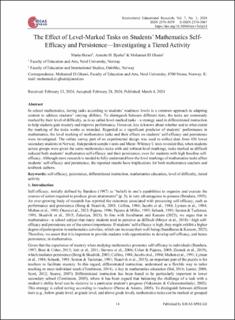The effect of level-marked tasks on students’ mathematics self-efficacy and persistence - Investigating a tiered activity
Peer reviewed, Journal article
Published version

Åpne
Permanent lenke
https://hdl.handle.net/11250/3126535Utgivelsesdato
2024Metadata
Vis full innførselSamlinger
Originalversjon
Herset, M., Bjerke, A. H. & El Ghami, M. (2024). The effect of level-marked tasks on students’ mathematics self-efficacy and persistence-Investigating a tiered activity. International Educational Research, 7(1), 14-29. doi: 10.30560/ier.v7n1p14Sammendrag
In school mathematics, tiering tasks according to students’ readiness levels is a common approach to adapting content to address students’ varying abilities. To distinguish between different tiers, the tasks are commonly marked by their level of difficulty, as in so called level-marked tasks – a strategy used in differentiated instruction to help students gain mastery and improve performance. However, less is known about whether and to what extent the marking of the tasks works as intended. Regarded as a significant predictor of students’ performance in mathematics, the level marking of mathematics tasks and their effects on students’ self-efficacy and persistence were investigated. The online survey part of an experimental design was used to collect data from 436 lower secondary students in Norway. Independent sample t-tests and Mann–Whitney U tests revealed that, when students across groups were given the same mathematics tasks with and without level markings, tasks marked as difficult reduced both students’ mathematics self-efficacy and their persistence, even for students with high baseline selfefficacy. Although more research is needed to fully understand how the level markings of mathematics tasks affect students’ self-efficacy and persistence, the reported results have implications for both mathematics teachers and textbook authors.
